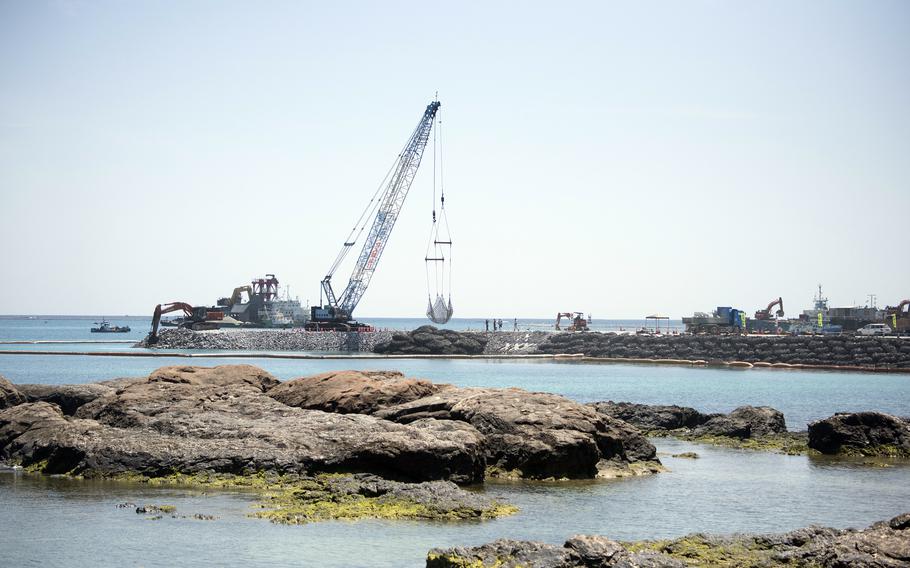
A crane moves material at the site of a future Marine Corps airfield at Camp Schwab, Okinawa, April 16, 2025. (Brian McElhiney/Stars and Stripes)
Work has been paused on a new Marine Corps airfield in northern Okinawa for more than a month, but the construction schedule will not be affected, according to Japan’s Ministry of Defense.
Six vessels contracted by the ministry to drive sand piles into the soft seabed of Oura Bay to reclaim land for a new airfield at Marine Corps Camp Schwab evacuated the area on June 10 due to a typhoon, a spokesman with the prefecture’s Seashore Disaster Prevention Division said by phone Thursday.
A spokesman with the Okinawa Defense Bureau — an arm of the defense ministry — declined to say when the vessels would return to work. However, no immediate delays to construction are expected, he said by phone Friday.
The first typhoon of the year appeared June 11 west of Taiwan in the South China Sea but did not approach Okinawa, according to the Japan Meteorological Agency.
“The Ministry of Defense will continue to steadily advance construction work for the Henoko relocation while paying attention to the safety of the work,” the bureau spokesman said.
Two of the vessels moved to Nakagusuku Bay in central Okinawa, and the other four relocated to Amami Island, north of Okinawa, the division spokesman said.
Some Japanese government officials speak to the media only on condition of anonymity.
Construction of the Schwab airfield has faced nearly a decade of delays.
Legal challenges from the Okinawa prefectural government delayed construction after the U.S. and Japanese governments agreed in 1996 to relocate the airfield from MCAS Futenma in densely populated Ginowan city to rural Henoko.
Work on the Oura Bay side was on hold from April 21, 2020, when Gov. Denny Tamaki, citing safety and environmental concerns, refused to approve design changes meant to solidify the seabed.
Japan’s Supreme Court in January rejected the final legal challenge and ended a series of 14 construction-related lawsuits filed by both sides since Nov. 17, 2015.
Contractors began driving sand piles to solidify the seabed on Dec. 28. About 2,800 piles out of 71,000 had been driven as of May 31, the division spokesman said.
In July, contractors drove test piles into the seabed to prepare the site for steel pipes that will support Seawall A. Construction began in August and contractors had driven 140 steel sheet piles for the seawall as of February, the spokesman said.
Construction is expected to last until at least 2033 and cost the Japanese government nearly $6 billion, Defense Minister Gen Nakatani said in January. The airfield may be ready for use by 2036, he said.